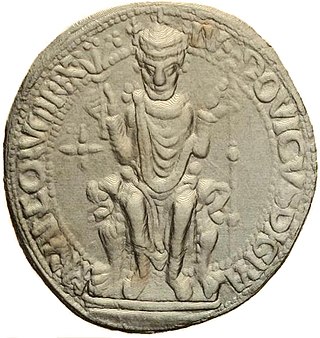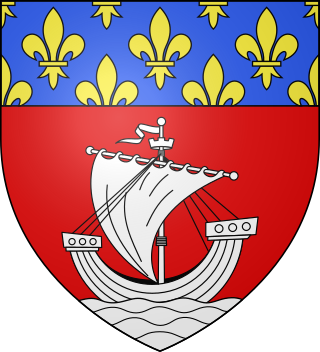Related Research Articles

| death_place = Béthisy-Saint-Pierre, France | burial_place = Saint Denis Basilica, Paris, France| }} Louis VI, called the Fat or the Fighter, was King of the Franks from 1108 to 1137. Like his father Philip I, Louis made a lasting contribution to centralizing the institutions of royal power. He spent much of his twenty-nine-year reign fighting either the "robber barons" who plagued the Ile de France or Henry I of England for his continental possession of Normandy. Nonetheless, Louis VI managed to reinforce his power considerably, often resorting to force to bring lawless knights to justice, and was the first member of the house of Capet to issue ordonnances applying to the whole of the kingdom of France.

Count of Paris was a title for the local magnate of the district around Paris in Carolingian times. After Hugh Capet was elected King of the Franks in 987, the title merged into the crown and fell into disuse. However, it was later revived by the Orléanist pretenders to the French throne in an attempt to evoke the legacy of Capet and his dynasty.

Alexandre Florian Joseph, Count Colonna-Walewski, also 1st Count of the Empire Colonna-Walewski, was a Polish and French politician and diplomat, the unacknowledged son of French emperor Napoleon I.
Ranulf I (820–866) was a Count of Poitiers and Duke of Aquitaine. He is the son of Gerard, Count of Auvergne. Few details are known about Ranulf I, except that he died in 866 in Aquitaine from wounds received in the Battle of Brissarthe against the Vikings.

The County of Loon was a county in the Holy Roman Empire, which corresponded approximately with the modern Belgian province of Limburg. It was named after the original seat of its count, Loon, which is today called Borgloon. During the middle ages the counts moved their court to a more central position in Kuringen, which today forms part of Hasselt, capital of the province.

Guillaume Jean Maxime Antoine Depardieu was a French actor, winner of a César Award, and the second oldest child of Gérard Depardieu.

François Pascal Simon Gérard, titled as Baron Gérard in 1809, was a French painter. He was born in Rome, where his father occupied a post in the house of the French ambassador, and his mother was Italian. After he was made a baron of the Empire in 1809 by Emperor Napoleon, he was known formally as Baron Gérard.

Girart de Roussillon, also called Girard, Gérard II, Gyrart de Vienne, and Girart de Fraite, was a Frankish Burgundian leader who became Count of Paris in 837, and embraced the cause of Lothair I against Charles the Bald. He was a son of Leuthard I, Count of Fézensac and Paris, and his wife Grimildis.
Herbert IV of Vermandois (1028–1080), Count of Vermandois, was the son of Otto of Vermandois and Parvie.

Theodoric I was the count of Bar and duke of Upper Lorraine from 978 to his death. He was the son and successor of Frederick I and Beatrice, daughter of Hugh the Great, count of Paris, and sister to the French king Hugh Capet.
Frederick I was the count of Bar and duke of Upper Lorraine. He was a son of Wigeric, count of Bidgau, also count palatine of Lorraine, and Cunigunda, and thus a sixth-generation descendant of Charlemagne.

Adalard (Adalhard) of Paris was the eighth Count of Paris and a Count palatine. He was the son of Wulfhard of Flavigny and Suzanne of Paris, a daughter of Beggo, Count of Toulouse. His brother Hilduin the Young was the abbot of Saint-Denis. His brother Wulgrin I of Angoulême was appointed Count of Angoulême and Périgord. Adalard succeeded his uncle Leuthard II as Count of Paris.
Bego was the son of Gerard I of Paris and Rotrude. He was appointed Count of Toulouse, Duke of Septimania, Duke of Aquitaine, and Margrave of the Hispanic March in 806 and followed his brother as Count of Paris in 813.
Rorgon I or Rorico(n) I was the first count of Maine and progenitor of the Rorgonid dynasty, which is named for him. He was count of Rennes from 819 and of Maine from 832 until his death.

Count of Boulogne was a historical title in the Kingdom of France. The city of Boulogne-sur-Mer became the centre of the County of Boulogne during the ninth century. Little is known of the early counts, but the first holder of the title is recorded in the 11th century.

Louis I was the Count of Loon, now in modern Belgium, and Burgrave of Mainz, in Germany. He inherited these offices from his father. He also established the County of Rieneck apparently based upon the Burgrave's lands.
Adrian of Orléans was a Frankish count, son of Gerold of Anglachgau and Emma of Alemannia. His sister Hildegard married Charlemagne; therefore, he was the emperor's brother-in-law and uncle to the next emperor, Louis the Pious.
Leuthard I of Paris was count of Paris and Fézensac.
Adalhard II was Count of Metz and Mozelgau. He was probably the son of Adalard the Seneschal
Count Gerard of Loon, was son and successor of Louis I, Count of Loon, and Agnes of Metz. He was count of Loon and of Rieneck. Because of a widespread misunderstanding concerning a document from 1101, some generations earlier, he is sometimes wrongly referred to as the second Gerard in this dynasty, "Gerard II".
References
- 1 2 3 4 Le Jan 2003, p. 442.